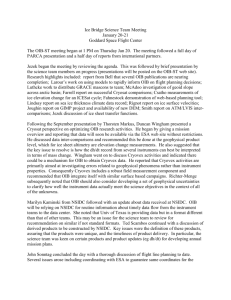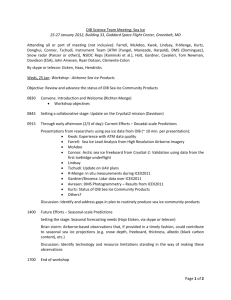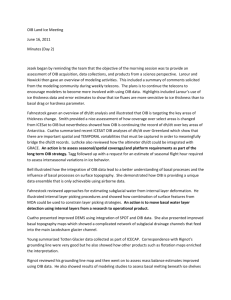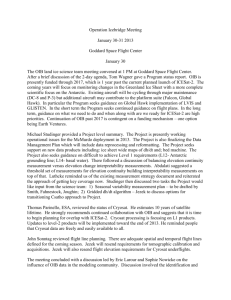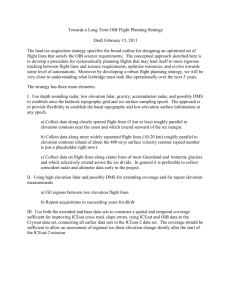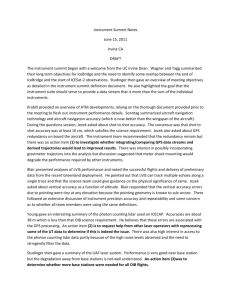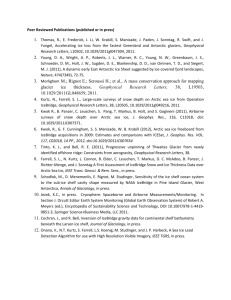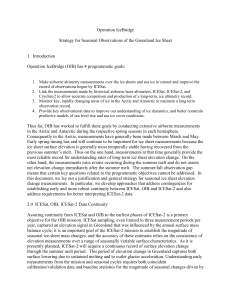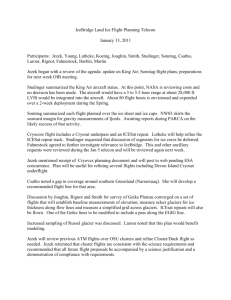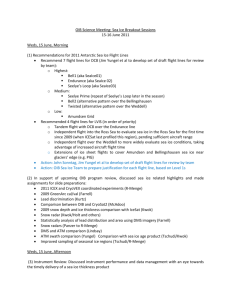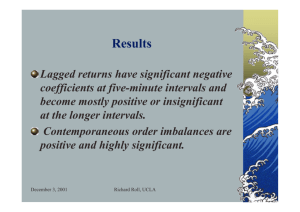Sept27_Minutes
advertisement
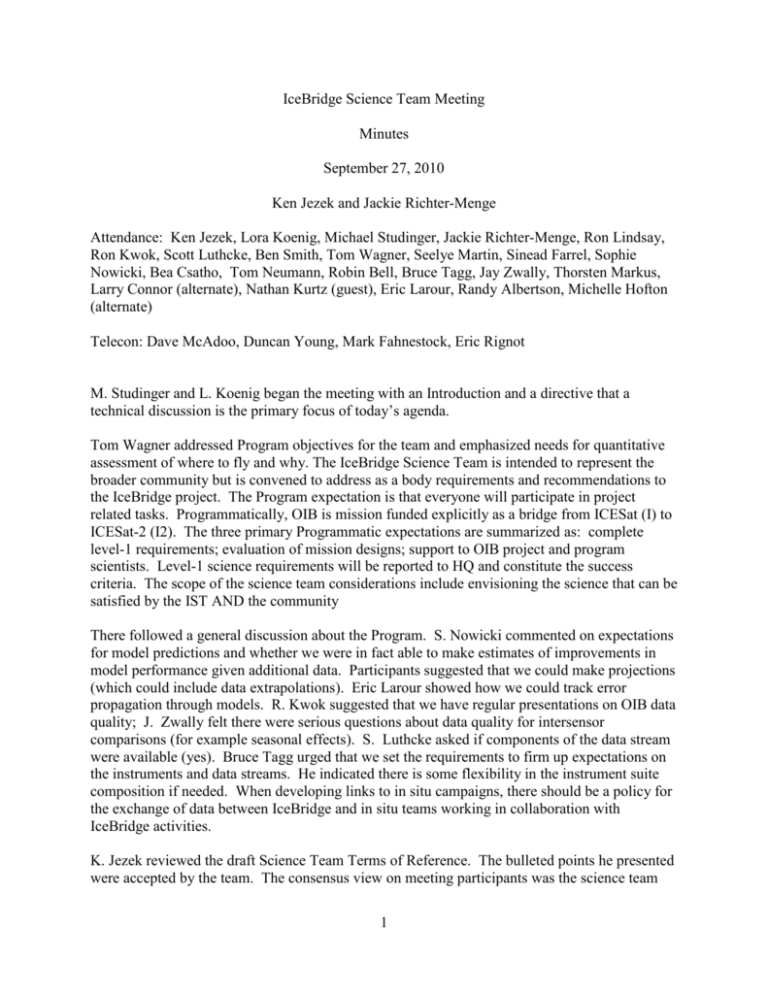
IceBridge Science Team Meeting Minutes September 27, 2010 Ken Jezek and Jackie Richter-Menge Attendance: Ken Jezek, Lora Koenig, Michael Studinger, Jackie Richter-Menge, Ron Lindsay, Ron Kwok, Scott Luthcke, Ben Smith, Tom Wagner, Seelye Martin, Sinead Farrel, Sophie Nowicki, Bea Csatho, Tom Neumann, Robin Bell, Bruce Tagg, Jay Zwally, Thorsten Markus, Larry Connor (alternate), Nathan Kurtz (guest), Eric Larour, Randy Albertson, Michelle Hofton (alternate) Telecon: Dave McAdoo, Duncan Young, Mark Fahnestock, Eric Rignot M. Studinger and L. Koenig began the meeting with an Introduction and a directive that a technical discussion is the primary focus of today’s agenda. Tom Wagner addressed Program objectives for the team and emphasized needs for quantitative assessment of where to fly and why. The IceBridge Science Team is intended to represent the broader community but is convened to address as a body requirements and recommendations to the IceBridge project. The Program expectation is that everyone will participate in project related tasks. Programmatically, OIB is mission funded explicitly as a bridge from ICESat (I) to ICESat-2 (I2). The three primary Programmatic expectations are summarized as: complete level-1 requirements; evaluation of mission designs; support to OIB project and program scientists. Level-1 science requirements will be reported to HQ and constitute the success criteria. The scope of the science team considerations include envisioning the science that can be satisfied by the IST AND the community There followed a general discussion about the Program. S. Nowicki commented on expectations for model predictions and whether we were in fact able to make estimates of improvements in model performance given additional data. Participants suggested that we could make projections (which could include data extrapolations). Eric Larour showed how we could track error propagation through models. R. Kwok suggested that we have regular presentations on OIB data quality; J. Zwally felt there were serious questions about data quality for intersensor comparisons (for example seasonal effects). S. Luthcke asked if components of the data stream were available (yes). Bruce Tagg urged that we set the requirements to firm up expectations on the instruments and data streams. He indicated there is some flexibility in the instrument suite composition if needed. When developing links to in situ campaigns, there should be a policy for the exchange of data between IceBridge and in situ teams working in collaboration with IceBridge activities. K. Jezek reviewed the draft Science Team Terms of Reference. The bulleted points he presented were accepted by the team. The consensus view on meeting participants was the science team 1 alternates will be allowed if they are Co-Is or close collaborators of the science team member. Observes from or visiting the host institution are welcome to sit in on the meetings. However time will be reserved at each team meeting for executive session. The last bullet concerning support of IST and community science objectives needs to be revised (KCJ will do). A0. KCJ to revise last bullet of Terms of Reference Slide A1. TW, KJ JM to communicate science team and operating venue expectations to the community. There was a break in the agenda for discussion of the Science Working Group and NSIDC. M. Maiden supports 4 FTEs at NSIDC for IceBridge data. SWG to advise NSIDC on types of data and data formats. It is NOT the job of the IST to develop specifications on data products and data formats. However some level of interaction between NSIDC and the IST should be established. A2. KJ and JRM will talk to NSIDC about data products (e.g. production of sea ice thickness products). Provide NSIDC with recommendations on data products while recognizing that data products are ‘not our job’! Link to NSIDC Wiki on IST web page. Thorsten Markus provided an overview of ICESat, ICESat-2 and how IceBridge could enhance the past and future satellite missions. He summarized key ICESat findings. First, dh/dt measurements over Greenland show mass loss is from the margins. The updated annual net loss is 170 GT. The recommendation is to measure ice elevation in rapidly changing sectors and in regions of higher slopes. J. Zwally suggested it is also important to make interior measurements where changes and slopes may be lower but the total area experiencing change may be large. Another major finding of ICESat is decreasing sea ice thickness (70 cm thickness decrease over the 5 years of ICESat; multiyear thickness is down by 42%). Recommendation is to refly Icebridge lines based on high gradients in thickness loss. 5 year planning can envision flights anywhere in Arctic. IST can assume improved aircraft capabilities with time (UAVs slower lower). In consideration of those observations ICESat 2 design is driven to multibeams (9 beams in 3 bands) which measure every 70 cm with 10 m footprint. Vertical accuracy is 10 cm. Improved coverage is achieved by 91 day repeat and multiple beams. Icebridge can support the ICESat 1/2 programs by select monitoring of ICESat tracks. Key areas are those undergoing rapid change and potentially long term change. This will continue the important time series of elevation change over key areas. OIB can also contribute through cross calibration with Cryosat. For mission continuity goals, S. Luthcke suggested that OIB sample lots of tracks and terrain vs specific flight tracks because of differences between I and I2 nadir tracks. Luthcke does not necessarily think we should fly along C1 tracks. J.Zwally argued that we need to repeat I tracks for continuing the record and tie through cross-overs to I2. When we know the I2 orbit then we can add underflights of I2 tracks. 2 The benefit of OIB to I and I2 science is to continue the elevation change record by monitoring tracks that span a range of regimes, snow on sea ice. There is an opportunity to improve I products by acquiring cross track slope data as input to improve I interpretation. OIB will also tie dh/dt records together (I, C2, I2). Another complement to the I record is to obtain data in regions where I data are sparse. B. Smith reported that there are places on PIG and Peninsula where clouds limit I coverage same in Southern Greenland where slopes are high. There is a real opportunity to improve I1 data by updating slopes. Flight lines to be defined in terms of those I1 science improvements. Also OIB can refine estimates of interior thickness/mass increases in gravity missions (GRACE). A3. Scott to send recommendation on how GRACE can be improved by incorporating IceBridge data. General discussion followed and B. Csatho noted that the dh/dt record is non linear. So we cannot simply extrapolate changes spatially or temporally. We need OIB to characterize the functional change. R. Kwok commented that snow depth informs about accumulation models. We can measure a trend in snow depth over the 5 years of OIB. These data will then revise the I record once we know how to pile snow on the ice. Jezek asked how do we address the synoptic scale processes implicit in the snow on sea ice issue. R. Lindsay noted that snow data are critical to ice thickness estimates and thermodynamics. Good snow data could bias correct ECMWF type reanalysis. There is the potential to expand coverage to synoptic scale with UAVs Markus continued with a discussion of how OIB can enhance the transition from I1 to I2. OIB can continue the change record; provide cross calibration between 3 instruments. To accomplish this there is a need for well established instrument configuration control. We will need to plan some flights beneath I2 as we get close to launch and the orbit is better defined. We can also cross calibrate with the I2 simulator (MABEL) flown on an ER2. First MABEL flights will be in April 2011 (out out of Goose Bay and flight lines may be configured for both sea ice and ice sheets). The second deployment is April 2012 (sea ice focus out of Alaska). MABEL is a different instrument technically, mounted on a different aircraft, organized under different management – OIB still needs to coordinate through for example possible MABEL/LVIS intercomparisons. Markus commented on tying I to C2 to I2 science. Cyrosat could help extrapolate OIB data to larger scales. R. Kwok was concerned about cross calibration with Cryosat for sea ice because of temporal constraints. We need coincident radar and lidar data for snow loading. Markus concluded with comments on how OIB could contribute to planning for I2. Contribution is primarily through assessing algorithm performance error sources and uncertainties. An approach is to coordinate MABEL and OIB coincident data. Nearer to launch line up I1 OIB and I2 orbits for detailed comparison. We need a clear cal val strategy. A 4 Team members with cal val interests need to volunteer to develop instrument intercomparison plan (Luthcke?) 3 J. Richter-Menge opened the discussion of Science Team Objectives. She reviewed the basic IST functions – science priorities to requirements to flight lines and then evaluation. We will reevaluate the science priorities over time also in context of changing platforms. A general discussion followed. M. Studinger pointed out that instrument configuration control is already in the project plan. Planning against seasonal signatures and episodic events was discussed. M. Fahnestock suggested that the seasonal signal in GRACE is well sampled in time but less so spatially. OIB needs to document the annual elevation change signal for unraveling dynamic versus climatic signals from GRACE data. Doing so would put OIB into Greenland in late summer/fall. Eric Rignot commented that the seasonal signal on ice sheets is strongly influenced by surface melt down. There are likely similar issues for seasonal monitoring of snow cover on sea ice. Eric Rignot raised the potentially adverse impact of seasonal deployments on logistics and personnel. M. Studinger and B. Tagg indicated that there could be assets available for those sorts of campaigns. Finally, linking our discussions to ICECAP and IST input to ICECAP flight lines was discussed. D. Young reported there are extensive plans for flights on the Atlantic side of Antarctica around to DuMont Durville and on to WAIS. An issue is that there are many international participants who also must be consulted. A5 Duncan to provide ICECAP flight line plans to the team. The IST agreed that we need easy access to all flight planning information. A6 M. Fahnestock needs flight lines from each OIB team component. He can then provide coordinates in tables. Mark is accumulating information on where data are acquired. This task is done. M. Fahnestock needs to implement a similar capability for Greenland. E. Larour noted that many science questions cannot be answered with OIB data alone. In particular there is need for velocity data, which can be provided through the MEASURES program and RGPS. Based on the need for data during the OIB period, the team proposed the following: A7 E. Rignot, I. Joughin, R. Kwok to draft a recommendation from the IST to the Project and Program on access to InSAR data J. Richter Menge next led a discussion of each team member’s science and project objectives. General discussion during the review included the issue of relationships to other federal projects were discussed in connection with sea ice. D. McAdoo to be the NOAA rep on the Science Team. McAdoo and Conner to link OIB planning with NOAA Arctic program. A8 D. McAdoo to provide a link between NOAA and IceBridge planning and implementation. B. Smith argued that there was value in collecting IceBridge data under cloudy conditions to test sensor and algorithm performance in partially obscured conditions. Obscurants include ground 4 fog and blowing snow conditions. There are also implications of obscurants on data processing – so the data stream should not delete partial results. It is also useful to identify places where LVIS and ATM can see/not see the surface. Design cloud specific experiments to investigate the influence of the atmosphere. M. Studinger gave a brief summary of OIB instrumentation. An important point is that LVIS is currently not mounted on the P-3 however a decision could be made to obtain another aircraft. He noted that depending on elevation, the instrument suite changes. A question to the science team is what is the optimal instrument suite and can ATM obtain a higher power laser for increased elevation deployments. The directive on instrumentation and platforms issues from Bruce Tagg is to maximize data collection. If different platforms are needed then specify. M. Studinger presented examples of radar results showing radar echoes in the upper few meters to the base of the ice sheet. Questions were raised about the process for inverting the radar data into geophysical quantities. For example, how and who are accumulations being extracted from the accumulation radar data. The team recommended that there be A9. A presentation on picking errors on Snow Accumulation radar from I. Joughin’s team. M. Fahnestock reiterated that we need maps where reliable data are collected for all sensors. S. Martin and L. Koenig presented a detailed review of IceBridge to date. Although activities are occurring in both poles, the specification that there are Phase1 and 2 IceBridge efforts is still in place. Consequently in Phase 1 there is approximately a 2 to 1 allocation of resources for Arctic compared to the Antarctic. At this point the IST began a discussion of science requirements. K. Jezek presented a brief overview of the Ice Sheet strategy for developing requirements and the general approach of linking overarching themes to science questions to program goals to observational objectives and then to science requirements was adopted. After several hours discussion the whole team reconvened. The Ice Sheet team made good progress on the top down traceability but needed much more work on the detailed requirements. A process was established for developing requirements for observational objectives. The sea ice team made good progress on detailed specifications but needs work on articulating the science themes and questions. The team will have a telecon on about Halloween to review progress in anticipation of having a draft document to the Project by mid November. B. Csatho suggested that we could glean ideas from the I2 science requirements. A10 Go through ICESat 2 science requirements and track to OIB reqs (Bea, Sinead, Ron, and Ben) Jezek ended the meeting with a review of the schedule (January meeting) and a summary of the action items. 5 September 28, Follow Up Discussions Participants: M. Studinger, L. Koenig, S. Martin, J. Richter Menge, K. Jezek, J. Sonntag Agenda for the January 19-21 meeting was reviewed. A11 Martin to send out details and invite international guests Schedule for science team deliverables was discussed. A12. Jezek to post schedule of deliverables Studinger briefed us on the Cryovex plans. Coordinated overflights of Devon Island and possibly a sea ice camp are excellent opportunities (depending on timing). The issue of a sensor intercomparison plan was also brought up A13 Jezek and Richter Menge to develop an outline of the plan A14 Richter Menge to approach 3 or 4 team members about taking the lead on plan and giving a presentation at the January meeting. There is a need to track OIB science progress in the form of tabulating papers. Encouraging people to cite the EOS paper is a good plan. Also having an OIB tailored acknowledgment on the NSIDC web page is important A15 Studinger/Koenig to draft an acknowledement and KCJ and JRM will discuss with NSIDC. Having information on where aircraft flew and where data were collected was discussed again. Mark Fahnestock’s site is doing that job admirably. A16 Fahnestock to have both Greenland and Antartica information on line by time of AGU town hall meeting. John Sonntag informed us that OIB Arctic 2010 trajectories are on the ATM web site. We also continued discussion of how dh/dt’s are computed given that data are reported for the current ITRF version. A17 Program and NSIDC need to determine whether elevation data need to be provided referenced to a common datum or whether each investigator is responsible for doing the transformations. Michael Studinger reiterated ‘level 1s level 1s level 1s’. Science team encouraged to review assignments and starting tabulating. 6 A18 Science team to have revised draft for Halloween telecon and a complete draft to the project by mid November. 7
